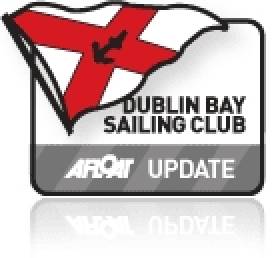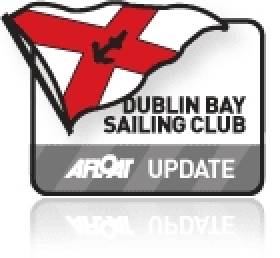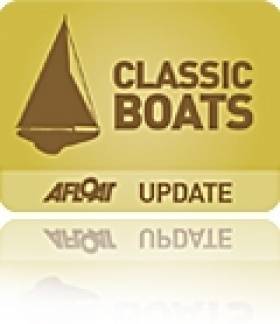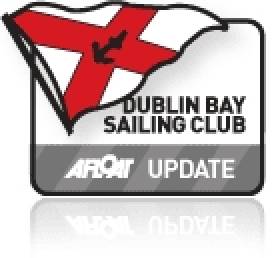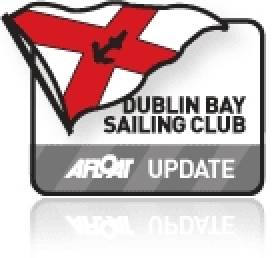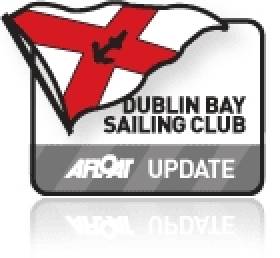Displaying items by tag: Dublin Bay Sailing Club
'No Age Bar' as Dublin Bay Sailing Club Surveys Sailors in Wake of National Dinghy Debate
#dbsc – The country's largest yacht racing club is surveying members on dinghy sailing requirements and has also moved to correct a perception that it operates an 'age bar'.
It follows a national debate on the state of dinghy racing that has led to sweeping change at the Irish Sailing Association.
Dublin Bay Sailing Club (DBSC) Commodore Pat Shannon says that the perception the club does not cater for under 18s has taken hold but it is not the case.
Writing on the DBSC website Shannon says 'The DBSC committee would like to make it clear to members, potential members, junior organisers and the wider community generally that such emphatically is not the case. It's a perception but an incorrect one.'
Shannon points to the fact that many boats on the DBSC register (of which there are over 300 and 1200 members) are crewed and sailed by young people under 18. At least three members of the current DBSC committee have sailed on DBSC keelboats since childhood. DBSC activities were recently reviewed by Afloat blogger WM Nixon.
It appears the misapprehension is perhaps understandable though, for while the Club throughout its history has welcomed all comers to membership, regardless of creed, gender or class distinctions, it no longer organises races for juniors. It did so in the past and, when support for this activity declined, joined the Dun Laoghaire clubs in organising the September Sunday series. It still provides logistical support – ribs and access to its results system and web site – but recently it decided not to be classed among the organisers.
This was prompted by the realisation that with the growing emphasis on child protection and parental involvement DBSC was not in a position to accept legal responsibility for an activity which was outside their competence and remit. The feeling was that the waterfront clubs, which were more closely and personally involved in the formation of young sailors, were in a better position to accept this responsibility.
Where some issues might arise with its present programme is with the Club's PY class. In recent times it has provided racing for a variety of Lasers (including Radials and 4.7s), OK Dinghies, RS200s and RS400s, Wayfarers and GP14s. Boats that are sailed uniquely by juniors such as Optimists and Toppers don't easily fit this particular mix. Not for reasons of safety, exactly, but because of potential race management and course setting problems on courses on which they would have to race alongside high performing boats like Flying 15s and Fireballs.
Shannon adds: 'I should add that DBSC, in common with sailing clubs everywhere, is having to review its dinghy programme. As part of this process, dinghy boat owners and others who might be concerned are currently receiving an on-line questionnaire asking for feed-back on the service provided'. The questionnaire is here.
Another dimension is that, with continuing austerity and the need to control its cost base, DBSC committee early this year decided to undertake a long-term strategic review of its racing programme – aiming perhaps for a consolidation of courses, with keelboats and dinghies racing from the a single committee vessel on adjoining or perhaps concentric circuits.
DBSC Spring Chicken Series Overall Results Published
#dbsc – DBSC regular Phil Smith sailing Just Jasmin has won the club's Spring Chicken series that concluded last Sunday. Full results for the six week event are downloadable below as MS word docs along with last Sunday's individual race scores. Albireo was second overall with Just Jasmin club mate WOW from the Royal Irish YC third.
#classicboat – W M Nixon's latest Irish sailing blog has drawing yachting historians into a facebook debate about historical yacht bow shapes. It started when Scottish reader Donan Raven from the Universtiy of Edinburgh sought further annotations on one of the early yacht racing images used by Nixon to illustrate his story on Dublin Bay Sailing Club and its 130th birthday celebrations this year. Read the comments so far by clicking on the facebook comments tab above.
As to the name of the clipper-bowed cutter in the RAYC 1888 photo, we haven't got it at the moment, but we'll set enquiries in train once St Patrick's Day has been put astern, says Nixon. Comment on facebook above. Read the full blog here.
Is Dublin Bay Sailing Club (DBSC) The Most Effective Sailing Organisation in the World?
#dbsc – Ireland's largest yacht racing organisation is Dublin Bay Sailing Club (DBSC), which administers the regular weekly programme for the entire Dun Laoghaire fleet. It has been such an accepted part of sailing's furniture for so long that it might be too easily taken for granted. W M Nixon salutes one of the great cornerstones of our world afloat.
Dublin Bay Sailing Club is 130 years old this year. Founded in 1884, it shares a birth year with the Gaelic Athletic Association. That's something I'd seldom heard mentioned by anyone, if at all, until the point was made in his foreword to the up-coming DBSC Yearbook 2014 by Commodore Pat Shannon. Yet it's a coincidence which is both incidental and fundamental. The two organisations in their very different ways are central to the areas of Irish life they serve so very well.
Perhaps the shared birth year goes unremarked simply because it's so bleeding obvious. So while we're on statements of fact from the IBO (the Institute of the Bleeding Obvious), might we be permitted another suggestion in that line? Sometimes, people from elsewhere wonder why major championships in GAA headquarters at Croke Park attract such enormous crowds, with upwards of 80,000 people roaring their hearts out. Naturally we'll respond to these outside enquiries with highfalutin lyricism about the sporting expression of Ireland in all her glory, the shared emotions, the rural soul of the nation. But on the other hand, at the end of the day (as they say in stadium sports), is it not something to do with the fact that, in our Gaelic sports, an Irish team always wins?
Be that as it may, there is equally something very Irish but also quintessentially Dublin – south Dublin, to be precise – about Dublin Bay SC. Its success owes much to the three great Ps – population, prosperity, and proximity. While most of the great cities of the world are coastal to some extent, few of them share Dublin's almost unique combination of circumstances which more or less force DBSC to thrive, even if today it is very different from the small boat sailing group which was set up in 1884.
Although the city is superbly situated on a graceful bay, the waters of Dublin Bay lend themselves much better to racing than cruising. You can have yourself a fine little cruise with many different natural mini ports of call within Sydney Harbour, and San Francisco is the same. As for the Solent or New York, or Washington and Baltimore, the choice of desirable sailing destinations within very easy reach is almost bewildering.
But in south Dublin, you have this intensely packed mostly affluent population crowded in along a fairly short bit of coastline, based around a large but entirely artificial harbour at Dun Laoghaire. There's immediate access to a rather open bay, but with no other proper harbours of significance within easy reach of an hour's sail other than Dublin Port itself. In such a location and with only two or three hours of spare time, what else can you do with a sailing boat but go racing?

The veteran Nich 31 Saki is one of the regular participants in DBSC Class 3 racing in Dublin Bay. So eclectic is the Dublin Bay cruiser fleet that Saki is by no means the most hefty boat regularly raced. Photo: David O'Brien
Thus one of the great strengths of DBSC, in its role as the overall racing body for the entire Dun Laoghaire fleet, is the provision of regular racing for large cruiser fleets which include some craft which, at any other port, would not be considered a racing proposition at all. But thanks to the sheer numbers of people wanting to get out and afloat and get a bit of fresh air on a Thursday night or Saturday afternoon or whenever, plus the impressive number of backroom volunteers who are prepared to record and analyse the results when they're provided with the elapsed times from real racing, an accurate picture of performance potential and a meaningful handicap system for just about anything that sails can evolve.
Obviously for this sort of intensely localised sport, a One Design class provides the most immediate return in quality of racing. And not surprisingly over the years, DBSC has been a stronghold and world leader of the One Design ideal. But it is a big enough and generous enough organisation to accept and accommodate a high level of individuality in boats and their owners, and the result at the height of the season is a social, sporting and seafaring phenomenon. People flock wearily homewards from work in the crowded city yet somehow - within minutes – they can be transformed into fully kitted energetic sailors out on the bay, shaping up for a start.
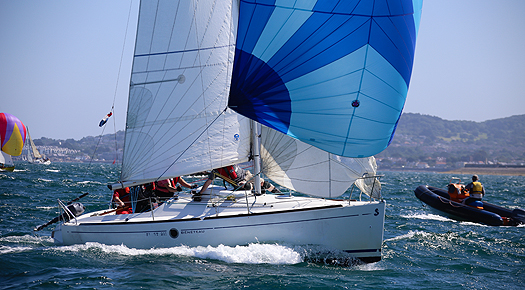
The 'new' Dublin Bay 21s, a contemporary Dublin Bay One design class. Photo: David O'Brien
But one way or another, Dun Laoghaire has a plethora of sailing clubs and organisations. How is it that the little club formed by Richard Fry and Dr W M A Wright and half a dozen friends in July1884 has become so pre-eminent? For, faced with a harbour dominated by the impressive clubhouses of the three established yacht clubs, DBSC's initial ambitions were very modest indeed, the club ethos being stated thus:
"In order to provide as much sport as possible with a minimum of expense, the races are to be strictly limited to open-sea boats with a light draught of water, such as can be easily rowed and beached if necessary".
Certainly as our lead photo from 1886 clearly shows, they fulfilled their original intentions to the letter. Yet within a dozen years, this unassuming little house-less club was promoting classes of substantial one design keelboats, and numbering among its active ordinary membership such social eminences as the Viceroy and other aristocrats who sailed.
At the time, the Royal Alfred Yacht Club, likewise a Dublin-based Corinthian organisation which functioned without a clubhouse, would have been expected to set the racing pace among the upper echelons of society. But the Alfred maybe set its sailing ambitions too high. Since 1870, it had been the lead club in formulating and developing the rules of yacht racing at national and international level. And it had always been a leading player in developing early offshore racing, with its Channel Matches an accepted part of the scene for many years.

A Royal Alfred YC Channel Match gets started in Dublin Bay in 1888. While the RAYC was promoting its ideals internationally and providing challenges for larger craft, Dublin Bay SC was quietly building its strength in their shared home waters with local boats.
Thus the Alfred's sights were set too high to cater for everyday Dublin Bay racing, week after week. Then too, over the years, its name became meaningless. While it meant a lot in 1870, subsequently there'd be those who'd think Royal was a brand of custard, and as for Alfred, wasn't he the dim son of Queen Victoria who'd been named after the guy who burnt the cakes?
But Dublin Bay Sailing Club......now there's a brand name to kill for. Whether it's prawns or people or boats or places, Dublin Bay has a zing. Clearcut, instantly recognisable, homely yet stylish, utterly reassuring, and only three very distinct syllables in just nine letters – Dublin Bay is a winner. In fact, you'd need to mess around big time to screw up the performance of an organisation called Dublin Bay Sailing Club. But happily there's never been any chance of that, as Dublin Bay SC dynamically reflects the basically very stable and successful society in which it is located.
An outsider looking at the history of Ireland in the first half of the 20th Century would wonder at this claim of "stable and successful". After all, were there not happenings like the Easter Rising, the War of Independence, and the Civil War crowded one upon the other in a turmoil to which the horror of the Great War of 1914-18 was the ghastly background? Maybe so, but as one of the members of the first Government of the Irish Free State put it, "we are the most conservative revolutionaries who ever lived". Several of these "conservative revolutionaries" lived in solid bourgeois comfort in the prosperous south Dublin community which saw Dun Laoghaire harbour as the centre of its nautical playground. And the private atmosphere of the yacht clubs had provided secure settings for negotiations over some of the key understandings and treaties which ended those troubles.
So south Dublin is used to getting on with it in a civilised way, and this attitude is transferred to its sport afloat. By the 1890s, with the emerging middle classes setting the developmental pace ashore and afloat, Dublin Bay SC was the right organisation in the right place at the right time in the Golden Age of yachting.
The actual Golden Age of sailing lasted only around a dozen years. Many factors contributed to the slowing of the pace, not least the growth of newer and more specialised shore sports. And we should never underestimate the rival attraction of the increasing popularity of the motor car, while aeroplanes also took some noted innovators off the sailing scene.
But for solid sailing enthusiasts, Dublin Bay SC was, and stayed, and still is, perhaps the most effective sailing organisation in the world. As it got into its stride in the 1890s, it blossomed with the promotion of the One Design Dublin Bay 25 in 1898, with the Viceroy Lord Dudley the owner of No 1, Fodhla, bought for him as a surprise birthday present by his wife.
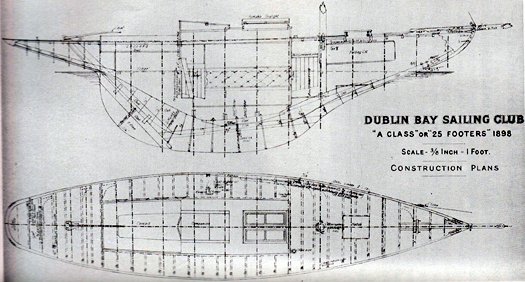
Quantum leap. The plans for the new Dublin Bay 25 in 1898. For a club which had started with small boats only fourteen years earlier, this was a remarkable development.
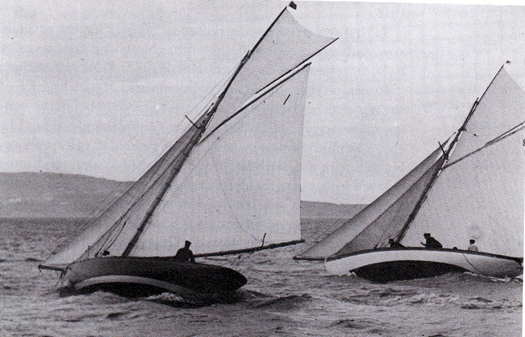
High society. DBSC member Lord Dudley racing his new Dublin Bay 25 Fodhla against R B MacDermott's sister-ship Acushla. Photo: Courtesy DBSC
Soon after, the Dublin Bay 21s hit the scene in 1902-03, and this underlined the sheer strength of the powerhouse which Dublin Bay sailing was becoming. Like it or not, it was metropolitan muscle, bringing good business to favoured boatyards near and far. There's a whole world in this photo of the Dublin Bay 21 Garavoge about to be launched in 1903 from James Kelly's little boatyard at Portrush on the North Coast.

The new Dublin Bay 21 Garavoge ready for launching in 1903 at Portrush with the DBSC burgee on stemhead, a great moment for owner W R Richardson, who stands proudly on left. Builder James Kelly, who four years later was to build the seven Dublin Bay 17s for DBSC members, is in the group on the right. Photo courtesy Robin Ruddock
Not all Dublin Bay one design and restricted classes were a continuing success. The boats built to the Half Rater rule., startlingly like early Flying Fifteens, proved too hairy and dangerous even for the hard-driving sailors of Ireland's east coast, and they were soon phased out. Then too the Colleens, ballasted centreboarders created by local builder James Doyle, capsized a couple of times too often to be cherished.
But the demise of the Colleens gave further indication of DBSC's steadily increasing power. In 1906 the Club was casting about for an able keelboat to replace the Colleens, and after much discussion they decided to use the design for the Howth 17s, which had been racing happily since 1898 as an able little keelboat one design in the waters of terra incognita way beyond Howth Head.
Herbert Boyd, Commodore of Howth SC from its inception in 1895 until his death in 1948, had designed the Howth 17s himself. But he was so chuffed that DBSC wanted to use his creation that he tidied it up, accepted that south of the Baily it would be known as the Dublin Bay 17, and even designed the option of a slightly larger cockpit, as it was acknowledged that Southsiders tended to be a little more portly than the lean and hungry Eastsiders of Howth.
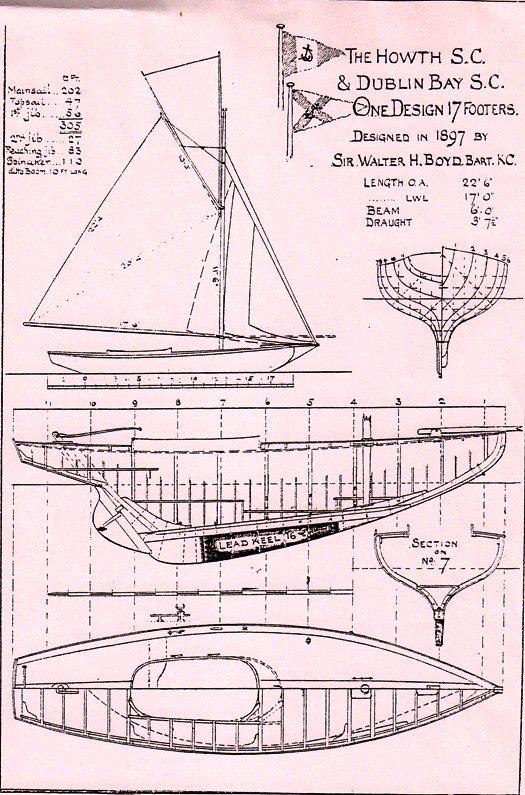
Plans of the "Dublin Bay 17" as tidied up by designer Herbert Boyd for the new Southside division of the class in 1907. As the Southsiders were better fed, they requested the option of a slightly larger cockpit.
It is now more than forty years since all the boats to the Seventeen foot design were re-grouped in Howth in 1972, yet you will still hear some absent-minded old buffers describing them as the "Dublin Bay 17s". All of which underlines the sheer power of the Dublin Bay brand. It's not that DBSC throws its weight about. On the contrary, it is a world leader in doing good work by stealth. But here it is, this enormous benign presence, and in the final analysis its word is law.
Currently, the classic case in point is the demise in Dun Laoghaire of the 17ft Mermaid Class. Designed by John Kearney in 1932 in response to requests from DBSC members, it became recognised as a class known as the Dublin Bay Mermaid in 1936. In its day, the Mermaid was a huge part of the fabric of Irish sailing, and its strength in Dublin Bay was phenomenal. But Dublin Bay moves on, however gently it may do so. Over the years it has allowed classes to wither and die as nature intended, while its members take up new boat challenges, often playing a key role in their development from the start.
So for the first time since 1936, there'll be no racing for Mermaids in Dublin Bay in 2014. Last year, they could theoretically muster half a dozen boats, but on the water the crucial figure of five boats racing to make the cut often wasn't happening. So now they're gone, to make way for new classes which rapidly achieve astonishing figures and take sailing in a fresh direction, such as the thriving First 211s.
However, part of the strength of DBSC is that the club accurately reflects what's happening afloat. Wooden boat racing may have suffered one blow with the end of Mermaid racing, but the energetic Water Wags seem to go from strength to strength. Originating in 1887, the class set a precedent in 1903 by retaining its class organisation, yet changing its boat type completely from a little double-ender to a much more substantial transom-sterned sailing dinghy, modern in its time, which today musters healthy fleet of more than two dozen.
But in a quietly but relentlessly forward-moving society like south Dublin, some boats inevitably fall by the wayside, and for wooden racing boats in Dun Laoghaire, size seems to be crucial for survival. The Water Wags may thrive, but the Mermaids – three feet longer – require that little bit of extra work, that final additional straw of shoreside man-handling which breaks the camel's back.
As for the Dublin Bay 21s and 25s and 24s, they're long gone. Whether the old 21s, mouldering in a Wicklow farmyard, ever sail again is a moot point. But it's still possible that their newer bigger sisters, the Dublin Bay 24s, will sail again as pampered toys known as Royal Alfred 38s in the South of France.
There's a considerable irony in this, as the pioneering 24s – boats conceived as slightly beefier seagoing Six Metres - were first suggested at a committee meeting of the Royal Alfred YC in 1934. It was a good idea, but the RAYC could carry it no further, so by the late 1930s they'd become the Dublin Bay 24s, and six were being built. World War II from 1939 to 1945 then interrupted their progress, but in 1947 the new Dublin Bay 24s made their debut, and they re-confirmed Dublin Bay SC in its pre-eminent role. They were brilliant boats for racing in the bay and at East Coast regattas, they could cut the mustard in RORC Racing (one of them won the RORC's Morecambe Bay race overall when it went through a gale in 1964), and they were superb fast cruisers, picking up several major ICC awards.
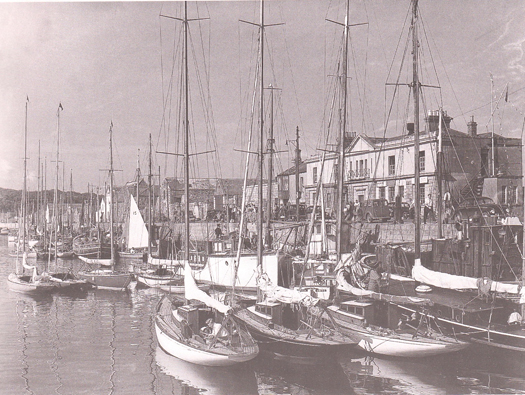
Three of the new Dublin Bay 24s make an impressive sight visiting Howth Regatta in 1953. Offering high quality racing in the bay, with wins offshore in RORC events, and proven cruising ability, in their day they were one of the most successful DBSC classes.
Yet the fact that the 24s are long gone from Dublin Bay is just the way it is. Life moves on, situations change, and DBSC - in successfully reflecting the sailing environment in which it functions - is in its understated way a genuine power in sailing, a thoroughly good thing.
It achieves this through a code of volunteerism which would be emulated by many other organisations, if only they knew the secret of the secret ingredient. It's difficult to pin it down, but the underlying DBSC ethos is found in all the memberships of the Dun Laoghaire clubs. But not necessarily in all the members. Serving Dublin Bay SC is a high calling, a vocation given only to a special few. And the people who run it are a band of brothers and sisters, who also happen to be the best of friends. The Code of the Bay is something that becomes elusive as you try to analyse it, so let's just be happy to enjoy it, savouring the wonderful sport provided by this extraordinary organisation for thousands of sailors in boats of every type.
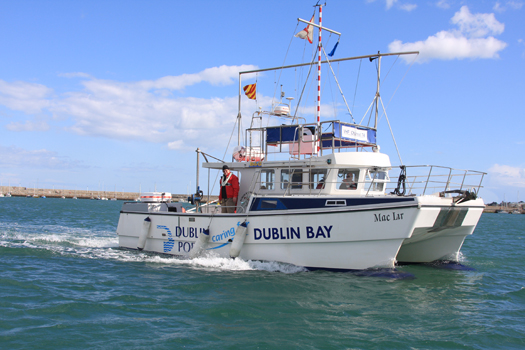
Mac Lir, one of two fast catamaran style Committee Vessels operated by DBSC on an all year round basis. Photo: David O'Brien
#dbsc – The finale of the Rathfarnham Ford Spring Chicken Series will feature an additional race held to be held on the final Sunday on 23rd March. The amendment to the sailing instructions was issued today in advance of next Sunday's racing in the 40–boat fleet. (Handicaps & Starts for next Sunday's race are attached. Although the overall results (also attached below) show a nice mix of boats at the top of the leaderboard a discard has yet to be applied. There will be no racing on Sunday 16th March.
#dbsc – A 1720 sportsboat named Deja Vu was the winner of the opening race of DBSC's Spring Chicken Series, second was the A35 Another Adventure and third was the Beneteau 34.7 Adelie. Full results are downloadable below. The six weeek series got off to a perfect start last weekend and the hope is a similar weather window might present itself again in the next 48–hours for the National Yacht Club hosted event. Attached are results from last Sunday and also Starts & Handicaps for this weekend.
Mermaid V Tops DBSC Turkey Shoot League on Dublin Bay
#DBSC – The Beneteau First 50, Mermaid V leads the overall rankings after four races of the 70–boat DBSC Turkey Shoot sponsored by Rathfarnham Ford. The series discard has been applied and this has tightened results. Full results downloadable below. Second overall is The Cartoonist and third is the new J70, J boats Ireland.
Dublin Bay Sailing Club (DBSC) Results for 28 September 2013
#DBSC - Here are the latest results from the Dublin Bay Sailing Club for Saturday 28 September, the last race of the Summer 2013 season.
BENETEAU 317 Echo - 1 Attitude (T Milner/J Sugars/M Branigan); 2 Extreme Reality (P McSwiney/E O’Rafferty); 3 Prospect (Chris Johnston)
BENETEAU 317 - 1 Prospect (Chris Johnston); 2 Attitude (T Milner/J Sugars/M Branigan); 3 Levante (M Leahy/J Power)
CRUISERS 0 Echo - 1 Loose Change (P Redden/M Mitton); 2 Lively Lady (Derek Martin); 3 Wow (George Sisk)
CRUISERS 0 - 1 Loose Change (P Redden & M Mitton); 2 Wow (George Sisk); 3 Lively Lady (Derek Martin)
CRUISERS 1 Echo - 1 Gringo (Tony Fox); 2 Powder Monkey (C Moore); 3 Boomerang (Paul Kirwan)
CRUISERS 1 - 1 Gringo (Tony Fox); 2 Ruth (L Shanahan); 3 Boomerang (Paul Kirwan)
CRUISERS 2 Echo - 1 Red Rhum (J Nicholson/C Nicholson); 2 Kamikaze (P Nash/B McIntyre); 3 Graduate (D O’Keeffe)
CRUISERS 2 - 1 Red Rhum (J Nicholson/C Nicholson); 2 Graduate (D O’Keeffe); 3 Jawesome 111 (M Dyke/B Darcy)
CRUISERS 3 - 1 Cartoon (McCormack/Brady/Lawless); 2 Quest (J Skerritt); 3 Jaws SeachangeNow (B Foley/J Bergon)
CRUISERS 3 Echo - 1 Jaws SeachangeNow (B Foley/J Bergon); 2 Cartoon (McCormack/Brady/Lawless); 3 Quest (J Skerritt)
FLYING FIFTEEN - 1 Flyer (Niall Coleman); 2 Thingamabob (T Galvin); 3 Kooigjug (K Dumpleton)
IDRA 14 FOOT - 1 Slipstream (Julie Ascoop); 2 Dart (Pierre Long); 3 Dunmoanin (Frank Hamilton)
MERMAID - 1 Tiller Girl (J O’Rourke); 2 Jill (P Smith/P Mangan); 3 Aideen (B Martin/D Brennan)
PY CLASS - 1 P Keane (Laser 1); 2 Alan McNab (Laser); 3 N O’Toole (Laser)
SIGMA 33 - 1 White Mischief (Timothy Goodbody); 2 Pastiche (T O’Neill et al); 3 Moonshine (R Moloney)
SQUIB - 1 Kookaburra (P & M Dee); 2 Femme Fatale (V Delaney); 3 Periguin (N Colcough)
Dublin Bay Sailing Club (DBSC) Results for 21 September 2013
BENETEAU 31.7 Echo- 1. Prima Nocte (Patrick Burke et al), 2. Attitude (T Milner J Sugars M Branigan), 3. Fiddly Bits (Timmins/Quigley/Murray/Breen)
BENETEAU 31.7 - 1. Prospect (Chris Johnston), 2. Levante (M.Leahy/J.Power), 3. Prima Nocte (Patrick Burke et al)
CRUISERS 0 Echo - 1. Wow (George Sisk), 2. Tsunami (Vincent Farrell), 3. Lively Lady (Derek Martin)
CRUISERS 0 - 1. Wow (George Sisk), 2. Tsunami (Vincent Farrell), 3. Lively Lady (Derek Martin)
CRUISERS 1 Echo - 1. Something Else (J.Hall et al), 2. Jump The Gun (M.Monaghan/J.Kelly), 3. Gringo (Tony Fox)
CRUISERS 1 - 1. Something Else (J.Hall et al), 2. Gringo (Tony Fox), 3. Raptor (D.Hewitt et al)
CRUISERS 2 Echo - 1. Cor Baby (Keith Kiernan et al), 2. Bendemeer (L Casey & D Power), 3. Kamikaze (P.Nash/B.McIntyre)
CRUISERS 2 - 1. Cor Baby (Keith Kiernan et al), 2. Red Rhum (J Nicholson & C Nicholson), 3. Bendemeer (L Casey & D Power)
CRUISERS 3 Echo - 1. Jaws SeachangeNow (B Foley/J Bergon), 2. Quest (J Skerritt), 3. Cri-Cri (P Colton)
CRUISERS 3 - 1. Quest (J Skerritt), 2. Cartoon (McCormack/Brady/Lawless), 3. Cri-Cri (P Colton)
FLYING FIFTEEN Race 1- 1. Fflogger (Alan Dooley), 2. The Gruffalo (Keith Poole), 3. The Big Bow Wow (N.Meagher/N.Matthews)
FLYING FIFTEEN Race 2- 1. The Gruffalo (Keith Poole), 2. Deranged (A Green/C Doorly), 3. Hi Fibre (Michael McCambridge)
GLEN - 1. Glencree (J.Bligh/H.Roche), 2. Pterodactyl (R & D McCaffrey), 3. Glendun (B.Denham et al)
IDRA 14 FOOT Race 1- 1. Dunmoanin (Frank Hamilton), 2. Dart (Pierre Long), 3. Doody (J.Fitzgerald/J.Byrne)
IDRA 14 FOOT Race 2- 1. Dunmoanin (Frank Hamilton), 2. Dart (Pierre Long), 3. Doody (J.Fitzgerald/J.Byrne)
MERMAID Race 1- 1. Lively Lady (G O'Neill & M Hanney), 2. Tiller Girl (J.O'Rourke), 3. Aideen (B.Martin/D.Brennan)
MERMAID Race 2- 1. Tiller Girl (J.O'Rourke), 2. Lively Lady (G O'Neill & M Hanney), 3. Aideen (B.Martin/D.Brennan)
PY CLASS Race 1- 1. N O'Toole (Laser)
RUFFIAN 23 - 1. Bandit (Kirwan/Cullen/Brown), 2. Ripples (Frank Bradley), 3. Alias (D.Meeke/M.McCarthy)
SHIPMAN - 1. Just Good Friends (J H O'Neill), 2. Curraglas (John Masterson), 3. Whiterock (Henry Robinson)
SIGMA 33 - 1. White Mischief (Timothy Goodbody), 2. Pastiche (T O'Neill et al), 3. Moonshine (R.Moloney)
SQUIB Race 1- 1. Little Demon (Sheila Power), 2. Nimble (Brian O'Hare), 3. Perfection (Jill Fleming)
SQUIB Race 2- 1. Nimble (Brian O'Hare), 2. Perfection (Jill Fleming), 3. Anemos (Pete & Ann Evans)
WHITE SAIL CRUISERS Echo - 1. Vespucci (S & K O'Regan), 2. Lucy O (Aonghus O hEocha), 3. Coumeenole (Bill Kavanagh)
WHITE SAIL CRUISERS - 1. Vespucci (S & K O'Regan), 2. Persistence (C. Broadhead et al), 3. Act Two (Michael O'Leary et al)
Dublin Bay Sailing Club (DBSC) Results for 7 September 2013
#DBSC - Here are the latest results from the Dublin Bay Sailing Club for Saturday 7 September:
BENETEAU 31.7 ECHO - 1 Extreme Reality (P McSwiney/E O’Rafferty); 2 Attitude (T Milner/J Sugars/M Branigan); 3 Magic (D O’Sullivan/D Espey)
BENETEAU 31.7 - 1 Magic (D O’Sullivan/D Espey); 2 Prospect (Chris Johnston); 3 Extreme Reality (P McSwiney/E O’Rafferty)
CRUISERS 1 ECHO - 1 Gringo (Tony Fox); 2 Jump The Gun (M Monaghan/J Kelly); 3 Axiom (M O’Neill)
CRUISERS 1 - 1 Gringo (Tony Fox); 2 Something Else (J Hall et al); 3 Jump The Gun (M Monaghan/J Kelly)
CRUISERS 2 ECHO - 1 Graduate (D O’Keeffe); 2 Peridot (Jim McCann et al); 3 Bendemeer (L Casey & D Power)
CRUISERS 2 - 1 Graduate (D O’Keeffe); 2 Red Rhum (J Nicholson & C Nicholson); 3 Peridot (Jim McCann et al)
CRUISERS 3 ECHO - 1 Quest (J Skerritt); 2 Cartoon (McCormack/Brady/Lawless); 3 Supernova (McStay/Timbs/Monaghan/Costello)
CRUISERS 3 - 1 Quest (J Skerritt); 2 Cartoon (McCormack/Brady/Lawless); 3 Asterix (Boushel/Meredith/Counihan)
FLYING FIFTEEN RACE 2 - 1 Deranged (A Green/C Doorly); 2 Fflogger (Alan Dooley); 3 Rollercoaster (Tom Murphy)
FLYING FIFTEEN RACE 1 - 1 The Gruffalo (Keith Poole); 2 Deranged (A Green/C Doorly); 3 Rollercoaster (Tom Murphy)
GLEN - 1 Glenluce (D & R O’Connor); 2 Glenshesk (L Faulkner et al); 3 Glenroan (Terence Moran)
RUFFIAN 23 - 1 Ruffles (Michael Cutliffe); 2 Bandit (Kirwan/Cullen/Brown); 3 Alias (D Meeke/M McCarthy)
SIGMA 33 - 1 White Mischief (Timothy Goodbody); 2 Rupert (R & P Lovegrove); 3 September Song (Barry Colleary)
SQUIB RACE 1 - 1 Nimble (Brian O’Hare); 2 Perfection (Jill Fleming); 3 Why Not (Derek & Jean Jago)
SQUIB RACE 2 - 1 Nimble (Brian O’Hare); 2 Perfection (Jill Fleming); 3 Tais (Michael O’Connell)
WHITE SAIL CRUISERS ECHO - 1 Act Two (Michael O’Leary et al); 2 The Great Escape (P & D Rigney); 3 Persistence (C Broadhead et al)
WHITE SAIL CRUISERS - 1 Act Two (Michael O’Leary et al); 2 Persistence (C Broadhead et al); 3 Calypso (Howard Knott)


























